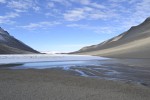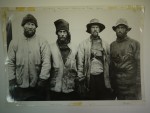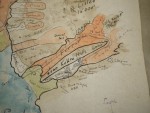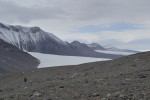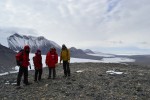The 100th anniversary of the first expeditions to reach the South Pole made the 2011-2012 field season an exciting time to be in Antarctica. One of the most interesting observations is how different experiences in the McMurdo Dry Valleys are now from those of the Antarctic explorers 100 years ago. Those explorers were cut off from loved ones for months and even years at a time; now it is possible to communicate with the outside world via satellite and IP phones. In talking with Antarctic scientists and contractors who have been working in the Dry Valleys for decades, it is clear that modes of communication have improved tremendously in recent years. This season the LTER Stream Team was even able to write a ‘real-time’ blog for the New York Times ‘Scientists at Work’ section (http://scientistatwork.blogs.nytimes.com/author/alia-khan/).
The 2011-2012 field season also saw the McMurdo (MCM) LTER program launch an innovative project to integrate environmental history into the scientific work of LTER, and a blog entry about the field trip to recreate one of the first historic journeys in the Dry Valleys made the front page of the New York Times.
Adrian Howkins, an environmental historian with the MCM LTER, has been researching the histories of the first explorers to the Dry Valleys, providing insight into human activity in the Valleys over the past 100 years.
The first documented trip into the Dry Valleys took place on December 18, 1903. It was led by Captain Scott on his first expedition to Antarctica. The explorers didn’t stay long, concluding that the McMurdo Dry Valleys were devoid of life. An entry in Scott’s journal reads: ‘It is certainly a valley of the dead, even the great glacier which once spanned the valley has since withered away.’ Given that the Dry Valleys are now an important center of ecological research, this quote shows how far we’ve come over the past 100 years in our scientific understanding of the region.
In February 1911 as part of Scott’s Terra Nova expedition, the young Australian geologist Griffith Taylor led the first scientific party into the Dry Valleys along with Frank Debenham, Charles Wright, and Edgar Evans. Within a one-week period, they hiked up and down what is now called the Taylor Valley, investigating its geology, geomorphology, and glaciology. In the upper part of the valley they took detailed notes of the lakes, streams, and glaciers, but in the lower part they had less time to explore. In Lake Chad the men searched for gold, but didn’t have any luck. The sifting pan was left by a rock because they didn’t want to carry it back to the ship, making it among the first pieces of “researcher trash” to be left on the Antarctic continent. Perhaps unsurprisingly in a place they believed to be devoid of life, Taylor and his companions paid little attention to the ecology of the Dry Valleys, although they did find algae in the lakes and streams, which shifted perceptions away from the idea of a “valley of the dead.”
After learning about these historical trips to the Dry Valleys, the LTER Stream Team decided to retrace a route up the Andrews Ridge documented in Taylor’s field journal. One of the motivating factors for retracing Taylor’s steps on this hike was to see if we could see Lake Fryxell from the top. Lake Fryxell is a prominent lake in the lower part of the Taylor Valley that is an important focus of LTER research. Surprisingly, the lake does not appear on Taylor’s published map of the region, though from the top of the Ridge we could see that it is clearly visible from the route taken by Taylor and Evans. This observation makes it’s the lake’s omission from the published map even more curious.
The omission of Lake Fryxell from Taylor’s map of the valley led us to conclude that it did not exist or might have been significantly smaller 100 years ago than it is today. It also encouraged us to rethink our calculations of the historical lake levels. Lyons and others (1998) suggested that Lake Fryxell had undergone a geologically recent drying downand was much smaller in the past, perhaps existing as a small hypersaline playa (a landlocked body of water with significant concentrations of mineral salts). Scientists estimate that the refilling event that brought the lake to its present size began about 750 years ago. However, dating the lake’s waters in 1993, scientists found that the top 11 meters could have been filled more recently (Hood et al., 1998). The scientific data, thus, indicate that the lake was probably present in 1911, but that it could have been smaller than it is today.
Although not as dramatic as discovering a “missing” lake this episode reveals some of the insights that can be gained from integrating historical research into LTER science. An historical perspective can raise new questions about past landscapes, and about ecological change over time. In turn, our scientific understanding of the McMurdo Dry Valleys can be used to validate historical sources. For example, Taylor’s omission of Lake Fryxell from his map of the Taylor Valley probably resulted from human error in the rush to publish the results of the expedition. But we can also surmise that there was little collaboration between Taylor, Wright, and Debenham in the publication of their data. We expect the historical work in the McMurdo Dry Valleys to present numerous other opportunities for history to inform LTER science and vice versa.

 Enlarge this image
Enlarge this image